Identifying Cysts Through Pictures
Medically reviewed by Susan Bard, MD
Are you experiencing an unsettling bump beneath your skin and suspect it might be a cyst? If so, you are in the right place.
Cysts can be found on various parts of the body, including the skin, scalp, face, neck, back, torso, and genitals. This article will explore the various types of cysts and help provide clarity by explaining potential symptoms alongside visual aids to help you better understand and identify them.
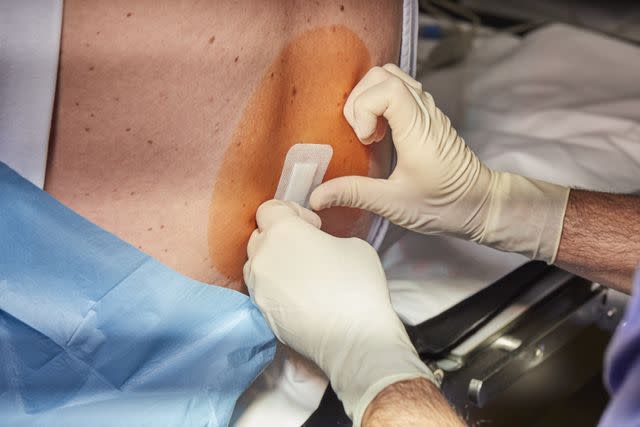
CasarsaGuru / Getty Images
How Cysts Look
Cysts are closed sacs found within the body and are common on the skin. They typically appear as round, fluid-filled sacs beneath the skin's surface. Cysts can vary in size, ranging from pea-sized to larger masses. Cysts often present on the skin's surface as raised bumps with a smooth or slightly uneven texture.
Skin cysts can occur on most body areas, including the head, face, chest, neck, and vagina. Depending on their location and composition, cysts may be flesh-colored, white, yellowish, or even reddish in hue. Fortunately, most cysts are benign (non-cancerous).
Facial
Cysts that commonly occur on the face and neck include epidermoid cysts. Facial cysts often appear as raised bumps with a smooth or slightly uneven texture, commonly occurring on the forehead, cheeks, or chin. They can vary in size from small to larger masses.
Scalp
Some cysts, such as pilar cysts, originate from hair follicles and tend to develop in areas where they are densely concentrated, such as the scalp or scrotum. However, these cysts can also occur on other body parts where hair follicles are present, such as the face, neck, or trunk.
Pilar cysts are like small, round bumps that can show up on your head or other parts of your body where hair grows. They feel firm to the touch and might have a smooth surface. Sometimes, they have a tiny hole in the middle.
Back or Torso
Cysts on the back or torso can vary in size and texture, presenting as round or oval lumps beneath the skin's surface, and may develop due to blocked hair follicles or oil glands.
Vaginal
A Bartholin's cyst is a fluid-filled sac that forms in one of the Bartholin's glands, which are located on either side of the vaginal opening. These cysts develop when the ducts of the Bartholin's glands become obstructed, leading to a buildup of fluid.
Bartholin's cysts can range in size from small to large and may cause discomfort or pain, especially during activities such as walking or sexual intercourse. While most Bartholin's cysts are benign and may resolve on their own, larger or symptomatic cysts may require medical intervention, such as drainage or surgical removal.
Cysts vs Boils
A cyst is a closed sac filled with fluid or semi-solid material, while a boil is a painful, pus-filled lump that forms when a hair follicle or oil gland becomes infected.
Types of Cysts: Pictures
Pictures may help others understand the different types of cysts by providing visual examples illustrating the characteristics and appearances of different cyst types.
Epidermoid Cyst
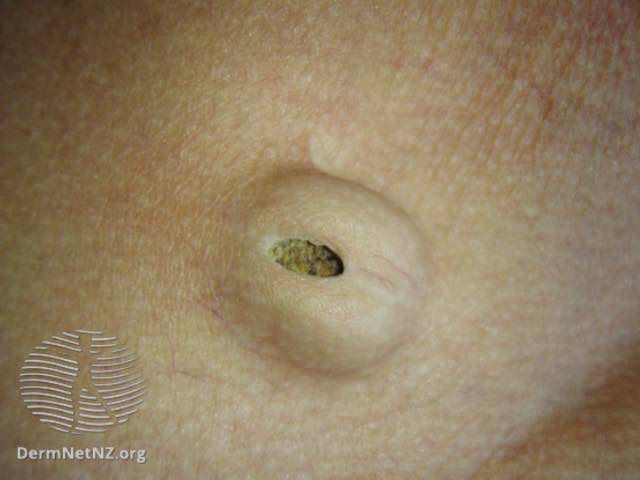
(image)
An epidermoid cyst, sometimes called a sebaceous cyst, develops when the top layer of skin cells (epidermis) grows inward instead of shedding normally, creating a sac beneath the skin.
These cysts are filled with a cheese-like substance called keratin and can vary in size from small to large. Epidermoid cysts are typically non-cancerous and may occur on any part of the body, commonly appearing on the face, neck, chest, or back.
Pilar Cyst
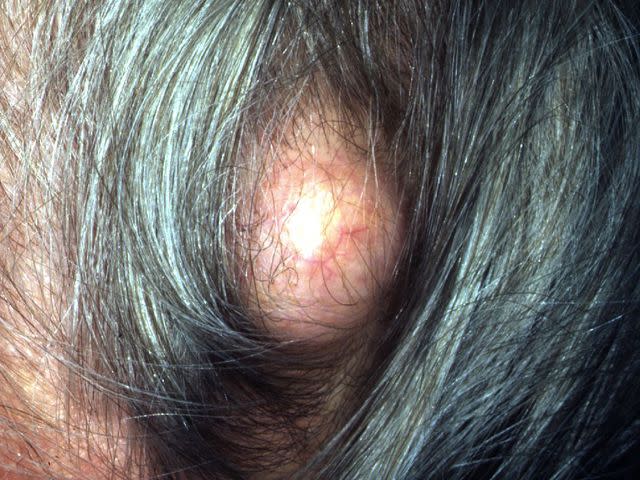
Reproduced with permission from © DermNet dermnetnz.org 2023
(image)
A pilar cyst, also known as a trichilemmal cyst, originates from hair follicles and is filled with keratin, similar to epidermoid cysts. These cysts typically develop on the scalp, although they can also develop in other areas where hair follicles are present.
Pilar cysts are often firm, smooth, and round in shape. Unlike epidermoid cysts, pilar cysts are more common in adults and tend to run in families.
Myxoid Cyst
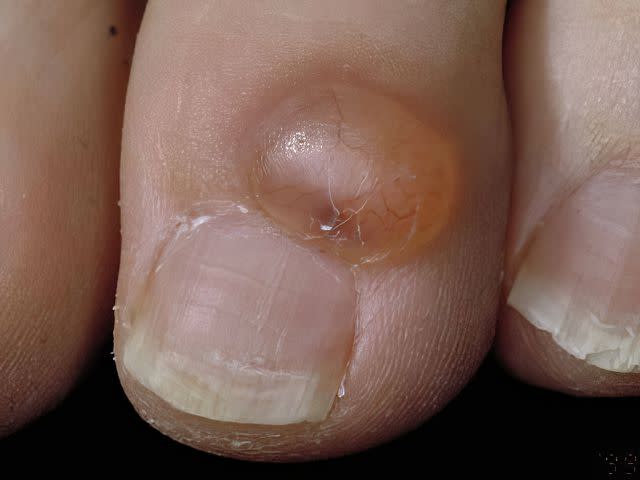
Reproduced with permission from © DermNet dermnetnz.org 2023
(image)
A myxoid cyst, also known as a digital mucous cyst, is a clear or skin-colored, non-cancerous growth that typically appears near the nail bed of the fingers or toes. These cysts contain gelatinous fluid and are often associated with osteoarthritis or other degenerative joint conditions.
While usually painless, myxoid cysts can cause discomfort or cosmetic concerns and may require medical treatment if they become bothersome.
Pilonidal cyst
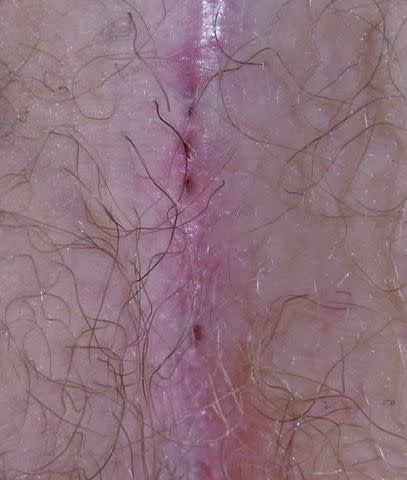
Reproduced with permission from © DermNet dermnetnz.org 2023
(image)
A pilonidal cyst is a type of cyst that develops in the cleft at the top of the buttocks. It typically occurs when hair follicles become inflamed and infected, leading to the formation of a painful lump or abscess.
Pilonidal cysts are more common in men and often result from friction or pressure in the area, such as prolonged sitting. Treatment usually involves draining the cyst and may require antibiotics or surgical removal to prevent recurrence.
Ruling Out a Cyst
If you think you may have a cyst, talk to your healthcare provider. Your provider can accurately diagnose the lump, determine if it is a cyst or another type of growth, and recommend appropriate management or further evaluation if needed.
To rule out a cyst, a healthcare provider may conduct a physical examination to assess the characteristics of the lump, such as its size, shape, and texture. In some cases, a biopsy may be performed, where a sample of tissue is taken from the lump and examined under a microscope to confirm the diagnosis.
When to See a Healthcare Provider
See your healthcare provider or a dermatologist if you detect any new growths on your body. While cysts are generally non-cancerous, it's essential to have your provider conduct a thorough examination to rule out any signs of skin cancer. Certain skin cancers can mimic cystic nodules, and it's crucial to have any new lumps assessed by your provider.
Additionally, if you experience any changes to your cyst, such as redness or pain, it's important to promptly contact your healthcare provider for further evaluation.
Summary
Cysts can be found in many body areas. Their color and appearance may depend on what caused them. While they are generally non-cancerous, contact your healthcare provider if you notice any new growth.
Read the original article on Verywell Health.

